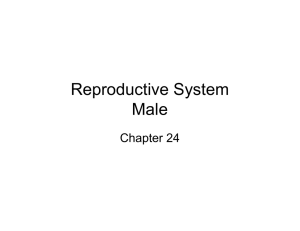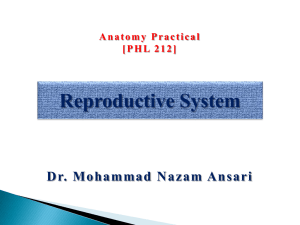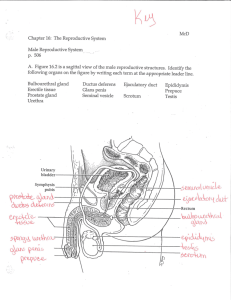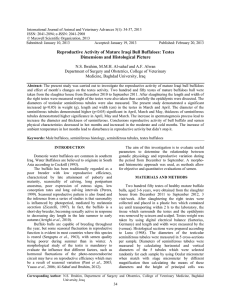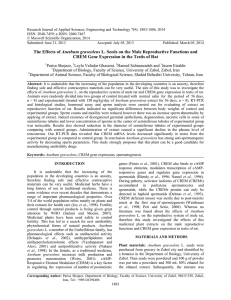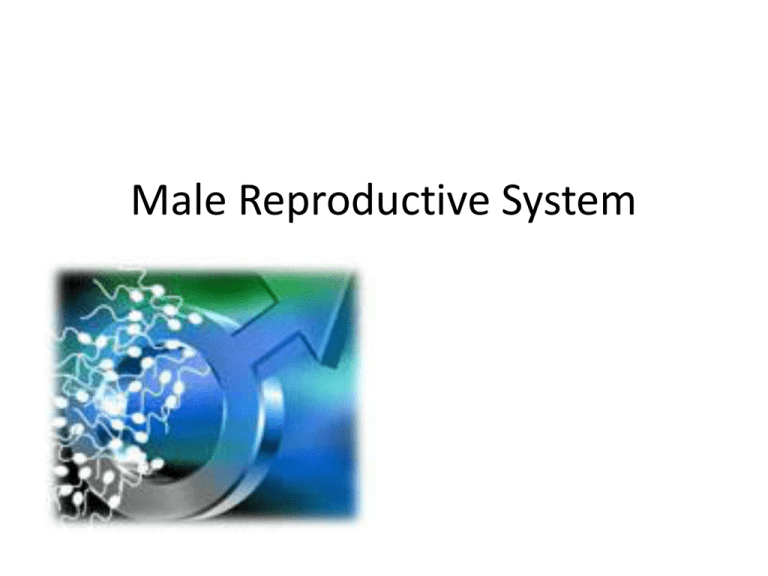
Male Reproductive System
Male Reproductive System
Labeling
Testis
Epididymis
Scrotum
Vas deferens
Prostate
Seminal vesicle
Urinary
bladder
Rectum
Penis
Cowper’s
Glands
Urethra
• Testes (2 of them)
Testes
– Male gonads
– Seminiferous tubules
• Site of sperm formation in the testes
• FSH stimulates sperm production
– Leydig cells (interstitial cells)
• Scattered among the seminiferous
tubules
• Produce testosterone
• LH stimulates testosterone
production
– Epididymis
• Tube in the testes where sperm gain
mobility
• Suspended in the scrotum
Urethra
• Tube that extends
from the bladder,
through the penis, to
the outside of the
body
• Carries semen and
urine
• 5-7 inches long in
male
Penis
• External male reproductive organ
• Glans penis - enlarged structure on the
end of the penis
– This is covered by the prepuce or foreskin
– The foreskin is removed in a procedure called
circumcision
• Penis is made of spongy, erectile tissue
– During sexual arousal, the erectile tissue
fills with blood from the arteries, causing
an erection
• Functions
– male organ of copulation/intercourse
– Elimination of urine from the bladder
Ejaculation
• The male gonads, or testes, consist of highly coiled tubes
surrounded by connective tissue
• Sperm form in these seminiferous tubules
• From the seminiferous tubules of a testis, sperm pass into the
coiled tubules of the epididymis
• During ejaculation, sperm are propelled through the muscular
vas deferens and the ejaculatory duct, and then exit the penis
through the urethra
Semen
• Three sets of accessory glands add secretions to the semen, the
fluid that is ejaculated
– The two seminal vesicles contribute about 60% of the total volume
of semen
– The prostate gland secretes its thin milky fluid containing enzymes
and sperm nourishment directly into the urethra
– The Cowper’s gland secretes a clear mucus before ejaculation that
neutralizes acidic urine remaining in the urethra
The Male Hormone Pattern
Reproductive Hormones
• Androgen: Testosterone
– Primary sex characteristics
• development of the vas deferens and other ducts
• development of the external reproductive structures
• sperm production
– Secondary sex characteristics
•
•
•
•
•
Deeper voice
Axillary and pubic hair
Chest and facial hair
Lengthen bones
Increased size of testes for sperm production
Reproductive Hormones
Gonadotropic Hormones
◦ Released from the Anterior Pituitary Gland
Follicle-Stimulating Hormone (FSH)
stimulates production of sperm
Luteinizing Hormone (LH)
stimulates secretion of testosterone
The Male Pattern
The Male Pattern
• The male hormone pattern is continuous.
• The principle male sex hormones are
androgens specifically testosterone.
• Gonadotropin-Releasing Hormone (GnRH)
– Produced by the hypothalamus
– Regulates FSH and LH levels
– Controlled by negative feedback from FSH and LH
Sperm Production Regulation
Copyright Pearson Prentice Hall
Spermatogenesis
• Process of sperm production
• Continuous process that begins at puberty
and continues through life
• LH induces Leydig cells to produce
testosterone
• Together with FSH, testoterone stimulates
sperm production in the seminiferous tubules.
Testicular Cancer
Cancer of the testicles
Frequent in men 20-35
Highly malignant and
spreads quickly
Treatment
◦ Orchiectomy, radiation
ACS
◦ American Cancer Society
◦ Recommends STE
◦ Self testicular exam



